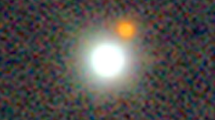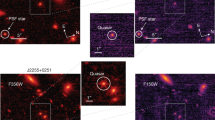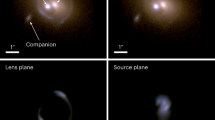Abstract
It has been speculated1,2 that the quasar pair 1146+B, C are two bright images of a single quasar produced by a gravitational lens. Here I report additional observations of these objects, made with an ultraviolet-sensitive spectrograph on the Multiple Mirror Telescope, which span the wavelength range 3,200–7,000 Å, and include the strong C III] line, as well as several Fe II bands not covered in earlier spectra. The ultraviolet spectra of the two quasars are different. There are also different velocity shifts between the quasars as measured by the C III] and Mg II lines. Although it is impossible to rule out the lensing hypothesis, these observations increase the probability that these objects are just two quasars at nearly the same redshift.
This is a preview of subscription content, access via your institution
Access options
Subscribe to this journal
Receive 51 print issues and online access
$199.00 per year
only $3.90 per issue
Buy this article
- Purchase on Springer Link
- Instant access to full article PDF
Prices may be subject to local taxes which are calculated during checkout
Similar content being viewed by others
References
Paczynski, B. Nature 319, 567–568 (1986).
Turner, E. et al. Nature 321, 142–144 (1986).
Hazard, C., Arp, H. C. & Morton, D. M. Nature 282, 271–272 (1979).
Arp, H. C. & Hazard, C. Astrophys. J. 240, 726–736 (1980).
Shaver, P. & Christiani, S. Nature 321, 585–586 (1986).
Geary, J., Huchra, J. & Latham, D. Soc. Photo-Optical Instrum. Engr (in the press).
Latham, D. in Instrumentation for Astronomy with Large Optical Telescopes (ed. Humphries, C.), 259–270 (Reidel, Dordrecht, 1982).
Grandi, S. Astrophys. J. 251, 451–464 (1981).
Hartig, G. & Baldwin, J. Astrophys. J. 302, 64–80 (1986).
Tyson, T. & Gullixson, C. Science (in the press).
Gaskell, C. M. Astrophys. J. 263, 79–86 (1982).
Wilkes, B. J. Mon. Not. R. astr. Soc. 207, 73–98 (1984).
Richstone, D. & Schmidt, M. Astrophys. J. 235, 361–376 (1980).
Yee, H. & Green, R. F. Astrophys. J. 280, 79–90 (1984).
Stockton, A. Astrophys. J. 223, 747–757 (1978).
Huchra, J. & Geller, M. Astrophys. J. 257, 423–437 (1982).
Phinney, E. S. & Blandford, R. Nature 321, 569–570 (1986).
Bahcall, J., Bahcall, N. & Schneider, D. Preprint.
Author information
Authors and Affiliations
Rights and permissions
About this article
Cite this article
Huchra, J. Is 1146+111B, C a lensed quasar or a quasar pair?. Nature 323, 784–786 (1986). https://doi.org/10.1038/323784a0
Received:
Accepted:
Issue Date:
DOI: https://doi.org/10.1038/323784a0
This article is cited by
-
Are binary quasars true pairs?
Astrophysics (1989)
-
Marginal gravitational lenses of large separation: probing superclusters
Nature (1987)
Comments
By submitting a comment you agree to abide by our Terms and Community Guidelines. If you find something abusive or that does not comply with our terms or guidelines please flag it as inappropriate.



